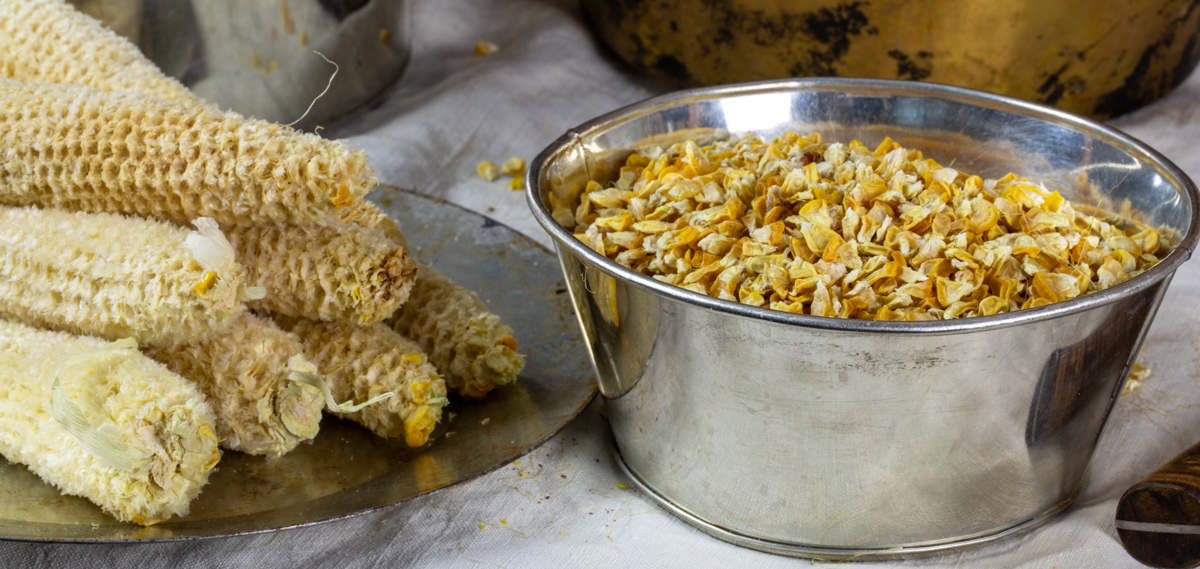The day at Fort Mandan is sunny and warm, so Clark has the party’s goods, parched corn meal, and clothing set out to air. This arouses the curiosity of visiting Knife River villagers. The enlisted men continue hulling corn.
Hulling Corn
by Yellowstone Public Radio[1]Originally aired weekdays by Yellowstone Public Radio during the Bicentennial observance of 2003-2006. Narrated by Hal Hansen. Scripts by Whit Hansen and Ed Jacobson. Produced by Leni Holliman. © … Continue reading
Hulling Corn
© 2020 by Kristopher K. Townsend. Permission to use granted under the Creative Commons Attribution-Share Alike 4.0 International license.
Some men employed Shelling corn.
—John OrdwaySet Some men about Hulling Corn &c.
—William Clark
Hulling was a process, typically using lye, of removing the inedible hulls and fibrous skins. This also made the corn nearly 20% lighter.[2]Alan H. Harley, Lewis & Clark Lexicon of Discovery (Pullman: WSU Press, 2004), 88.
Airing Out
a fine day I put out all the goods & Parch meal Clothing &c to Sun, a number of Indians here to day They make maney remarks respecting our goods &c.
—William Clark
Weather Diary
State of Ther. at rise
Weather wind at rise
State of Thermt. at 4 OClock Weather at 4 Ock Wind at 4 OClock State of the River 24 [above 0] fair S E 38 [above 0] fair W fall 1 inch —Meriwether Lewis[3]To assist the reader, the editor of this web page has omitted the “Day of Month 1805” column and spelled out some abbreviations.
Experience the Lewis and Clark Trail
The Lewis and Clark Trail Experience—our sister site at lewisandclark.travel—connects the world to people and places on the Lewis and Clark Trail.
Plan a trip related to March 15, 1805:

Fort Mandan is a High Potential Historic Site along the Lewis and Clark National Historic Trail managed by the U.S. National Park Service. The North Dakota Department of Parks and Recreation manages a modern reconstruction and the Lewis and Clark Interpretive Center located at US Hwy 83 and ND Hwy 200A.
Knife River Indian Villages National Historic Site is a High Potential Historic Site along the Lewis and Clark National Historic Trail managed by the U.S. National Park Service. A unit of the National Park System, the site is located at 564 County Road 37, one-half mile north of Stanton, North Dakota. It has exhibits, trails, and a visitor center.
Notes
| ↑1 | Originally aired weekdays by Yellowstone Public Radio during the Bicentennial observance of 2003-2006. Narrated by Hal Hansen. Scripts by Whit Hansen and Ed Jacobson. Produced by Leni Holliman. © 2003 by Yellowstone Public Radio. |
|---|---|
| ↑2 | Alan H. Harley, Lewis & Clark Lexicon of Discovery (Pullman: WSU Press, 2004), 88. |
| ↑3 | To assist the reader, the editor of this web page has omitted the “Day of Month 1805” column and spelled out some abbreviations. |



